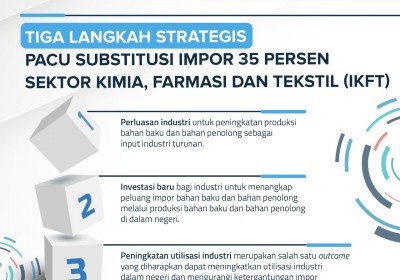Three Key Strategies to Meet the IKFT's 35% Imports Substitution Target
May 19, 2021
JAKARTA – To restore the national trade balance, the government has set an import substitution target of 35% for raw production materials used by processing industries by 2022.
The import substitution policy is one of the government’s strategic steps to not only drive up the consumption of locally-sourced production materials, but to also stimulate national industries to reduce their dependency on imports.
The Industry Ministry’s (Kemenperin) director general for chemical, pharmaceutical and textile industry (IKFT) affairs Muhammad Khayam said that his ministry is focused on driving down imports of raw production materials, supporting materials and finished products. To do so, there needs to be clear synchronization with relevant industry stakeholders.
“However, reducing the dependency on production material imports remains the main goal, especially approaches which would not disrupt current production processes,” Muhammad Khayam said in a written statement on Thursday (6/5).
The government has identified several effective import substitution approaches.
The first one is to expand industries to be able to increase production of raw production materials to help supply local industries. This approach is specifically tailored for existing raw material producers to increase their production volume and domestic supply capacity.
The second approach is to attract new investment to domestic material production industries. The third is to increase industrial utilization of domestic industries.
“Import substitution cannot be achieved simply by reducing imports. That is why these three approaches are important to consider and are crucial for us to achieve our 35% import substitution target by 2022,” Khayam added.
He added that the IKFT sectors have the potential to contribute heavily to the success of these import substitution plans. For example, the economic contribution of the pharmaceutical, chemical medicine and traditional medicine industries managed to reach 9.39% last year, year-on-year.
“Meanwhile, the textile, chemical and pharmaceutical sectors contributed 4.48%, with the biggest contributor to that figure being the chemical, pharmaceutical and medicine industries, with 1.92%,” he explained.
Throughout 2020, the export levels of IKFT sectors reached US$33.99 billion, with a surplus of US$89 million. The largest contributor to this figure was the clothing and textiles industry, which managed to provide US$10.63 billion.
Investment realization in IKFT sectors in 2020 reached Rp 61.97 trillion, dominated by the chemical and chemical products industries. These sectors were also able to employ up to 6.24 million people, with the largest job provider being the textiles and clothing industries with 3.43 million people.
Indonesia’s Research Institutions Supporting the Development of the Electric Vehicle Industry
Indonesian Muslim Fashion and Cosmetics IKMs Shine at Dubai World Expo 2020
Govt Steps Up UMKM Transformation Efforts in the Midst of Pandemic Slowdown
Govt Encourages Promotion of IKM Products in Digital Era
Government Begins Developing Maritime Training Center in Makassar
Tweets by IDDevForum
